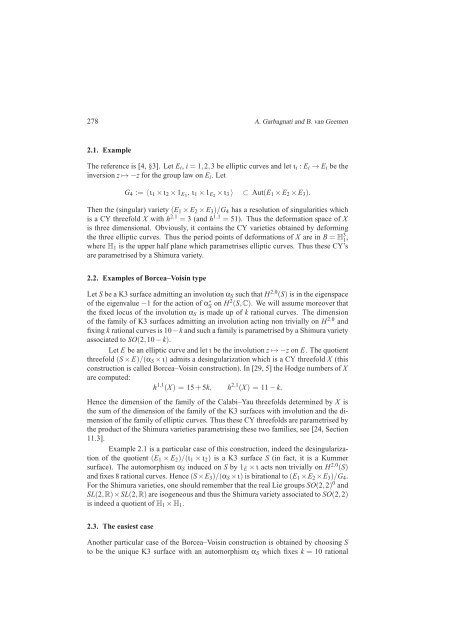Examples of Calabi-Yau threefolds parametrised by Shimura varieties
Examples of Calabi-Yau threefolds parametrised by Shimura varieties
Examples of Calabi-Yau threefolds parametrised by Shimura varieties
Create successful ePaper yourself
Turn your PDF publications into a flip-book with our unique Google optimized e-Paper software.
278 A. Garbagnati and B. van Geemen2.1. ExampleThe reference is [4, §3]. Let E i , i=1,2,3 be elliptic curves and let ι i : E i → E i be theinversion z↦→−z for the group law on E i . LetG 4 := 〈ι 1 × ι 2 × 1 E3 , ι 1 × 1 E2 × ι 3 〉 ⊂ Aut(E 1 × E 2 × E 3 ).Then the (singular) variety (E 1 × E 2 × E 3 )/G 4 has a resolution <strong>of</strong> singularities whichis a CY threefold X with h 2,1 = 3 (and h 1,1 = 51). Thus the deformation space <strong>of</strong> Xis three dimensional. Obviously, it contains the CY <strong>varieties</strong> obtained <strong>by</strong> deformingthe three elliptic curves. Thus the period points <strong>of</strong> deformations <strong>of</strong> X are in B =H 3 1 ,where H 1 is the upper half plane which parametrises elliptic curves. Thus these CY’sare <strong>parametrised</strong> <strong>by</strong> a <strong>Shimura</strong> variety.2.2. <strong>Examples</strong> <strong>of</strong> Borcea–Voisin typeLet S be a K3 surface admitting an involution α S such that H 2,0 (S) is in the eigenspace<strong>of</strong> the eigenvalue−1 for the action <strong>of</strong> α ∗ S on H2 (S,C). We will assume moreover thatthe fixed locus <strong>of</strong> the involution α S is made up <strong>of</strong> k rational curves. The dimension<strong>of</strong> the family <strong>of</strong> K3 surfaces admitting an involution acting non trivially on H 2,0 andfixing k rational curves is 10−k and such a family is <strong>parametrised</strong> <strong>by</strong> a <strong>Shimura</strong> varietyassociated to SO(2,10−k).Let E be an elliptic curve and let ι be the involution z↦→−z on E. The quotientthreefold (S×E)/(α S × ι) admits a desingularization which is a CY threefold X (thisconstruction is called Borcea–Voisin construction). In [29, 5] the Hodge numbers <strong>of</strong> Xare computed:h 1,1 (X) = 15+5k, h 2,1 (X) = 11−k.Hence the dimension <strong>of</strong> the family <strong>of</strong> the <strong>Calabi</strong>–<strong>Yau</strong> <strong>threefolds</strong> determined <strong>by</strong> X isthe sum <strong>of</strong> the dimension <strong>of</strong> the family <strong>of</strong> the K3 surfaces with involution and the dimension<strong>of</strong> the family <strong>of</strong> elliptic curves. Thus these CY <strong>threefolds</strong> are <strong>parametrised</strong> <strong>by</strong>the product <strong>of</strong> the <strong>Shimura</strong> <strong>varieties</strong> parametrising these two families, see [24, Section11.3].Example 2.1 is a particular case <strong>of</strong> this construction, indeed the desingularization<strong>of</strong> the quotient (E 1 × E 2 )/(ι 1 × ι 2 ) is a K3 surface S (in fact, it is a Kummersurface). The automorphism α S induced on S <strong>by</strong> 1 E × ι acts non trivially on H 2,0 (S)and fixes 8 rational curves. Hence(S×E 3 )/(α S ×ι) is birational to(E 1 ×E 2 ×E 3 )/G 4 .For the <strong>Shimura</strong> <strong>varieties</strong>, one should remember that the real Lie groups SO(2,2) 0 andSL(2,R)×SL(2,R) are isogeneous and thus the <strong>Shimura</strong> variety associated to SO(2,2)is indeed a quotient <strong>of</strong>H 1 ×H 1 .2.3. The easiest caseAnother particular case <strong>of</strong> the Borcea–Voisin construction is obtained <strong>by</strong> choosing Sto be the unique K3 surface with an automorphism α S which fixes k = 10 rational














